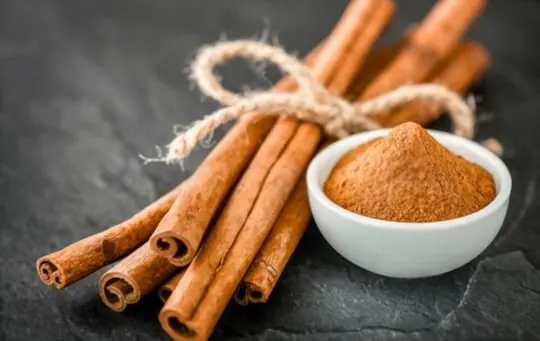Cinnamon Cassia and Cinnamon Bark toss up a spicy dilemma.
We’ve all been there, standing in the spice aisle, wondering which one to toss into our cart.
The difference isn’t just in the name. It’s a tale as old as time, or at least as old as cinnamon rolls.
One’s sweeter, one’s spicier. We’ve tried both, trust me.
Choosing can make or break your recipe. Know your cinnamon, folks.
Seriously, it’s a game changer.

What is Cinnamon Cassia?

Cinnamon Cassia is a type of cinnamon commonly found in the market.
It is derived from an evergreen tree native to China and Southeast Asia, and its scientific name is Cinnamomum cassia.
The bark of this tree is harvested and dried to produce the cinnamon spice used for various culinary and medicinal purposes globally.
Cinnamon Cassia has a sweet and slightly pungent aroma compared to other types of cinnamon, making it a popular choice for use in baking goods, desserts, and even savory dishes like curries.
This variety also contains higher levels of coumarin, a naturally occurring compound that can have adverse effects on the liver in large quantities.
What is Cinnamon Bark?

Cinnamon Bark is the inner bark of a small evergreen tree grown in South Asia.
It has a sweet aroma and distinct flavor used as a spice for culinary and medicinal purposes.
The bark, once harvested, is dried until it curls into quills before being sold in whole or ground forms.
While often used interchangeably with Cassia, there are differences between the two spices that impact their flavor profile and uses in different cuisines.
Differences Between Cinnamon Cassia and Cinnamon Bark

Cinnamon Cassia and Cinnamon Bark are two distinct types of cinnamon with varying characteristics.
Cassia cinnamon has a stronger flavor profile, while Cinnamon Bark has a sweeter taste and aroma.
Moreover, Cassia contains higher levels of coumarin, which can cause liver damage on overconsumption.
Conversely, Cinnamon Bark is more expensive and difficult to acquire due to its rarity and quality.
Hence, it is imperative for individuals to choose the right type of cinnamon based on their preferences and health criteria.
1 – Botanical Origin
Cinnamon is a spice obtained from the inner bark of trees belonging to the genus Cinnamomum.
The usage of cinnamon dates back to ancient times in various cultures for medicinal and culinary purposes.
There are two primary varieties of cinnamon, Cassia, and Ceylon.
Cassia cinnamon, also known as Chinese cinnamon, is obtained from the Cinnamomum cassia tree native to China and Burma.
Whereas Ceylon cinnamon, also known as true cinnamon, is extracted from the bark of trees grown primarily in Sri Lanka.
Both types have similar features but differ slightly in their taste, aroma, and texture.
Cassia has a sharp and pungent flavor with a reddish-brown coloration that looks beautiful but can sometimes overpower other flavors in dishes.
It is widely available and cheaper than its counterpart.
In contrast, Ceylon cinnamon has a subtle sweet aroma with complex notes of warm spiciness and woody undertones that add a delicate sweetness to dishes.
It is rare and expensive but generally considered healthier due to low levels of coumarin content (a toxic substance found in high amounts in Cassia which can cause liver damage).
Overall, both varieties possess health benefits such as anti-inflammatory properties and regulating blood sugar levels but choosing one depends on individual needs or preferences relating to taste, price or health concerns.
2 – Flavor and Aroma
While cinnamon is lauded for its multitude of health benefits, each variety – cassia and bark – have different flavor notes and aromas.
Cinnamon cassia offers a sharp, pungent taste with a distinct sweetness.
Its aroma is voluptuous, penetrating, and rich with spicy undertones.
Alternatively, cinnamon bark has a more delicate taste that’s both sweet and bitter, with less noticeable spicy tones.
Its scent is reminiscent of warm citrusy notes with mild woody hints.
It’s essential to understand the differences in these scents when selecting between the two.
For example, if you’re making an apple pie or French toast, cassia may be the preferred choice because of its sweet yet potent aroma.
Meanwhile, if you plan to bake savory dishes like lamb or chicken curry powder where cinnamon is featured as a spice rather than predominant flavoring agent, then cinnamon bark may be more suitable.
3 – Coumarin Content
The Coumarin levels in cinnamon cassia and cinnamon bark have always been a point of confusion for many.
It is important to note that coumarin is a compound found in both types of cinnamon, but they differ in concentrations.
Higher intake of coumarin can lead to liver damage and other health complications.
Interestingly, cinnamon bark has lower levels of coumarin compared to cinnamon cassia, making it a better option for those concerned about their health.
While Cassia has more pronounced sweet and spicy notes, consuming it frequently could pose health risks.
It’s also important to note that buying high-quality cinnamon from reputable sources is crucial as some brands may add cassia oil or other compounds to increase flavor or weight.
4 – Culinary Uses and Benefits
The savory and sweet flavors of cinnamon cassia and cinnamon bark make them popular ingredients used in a variety of dishes and cuisines worldwide.
These two types of cinnamon have different properties, making each one unique in its taste and health benefits.
Cinnamon cassia is more commonly used in savory dishes like curries and soups, while cinnamon bark is preferred for sweeter desserts like cakes and pastries.
Both types offer antioxidant and anti-inflammatory properties that can aid digestion, protect against heart disease, lower blood sugar levels, and boost brain function.
It’s important to note that consuming too much cinnamon cassia may cause liver damage due to the high amount of coumarin it contains.
Nevertheless, when used appropriately, both types offer an array of benefits to enhance the nutritional value of any meal.
Similarities Between Cinnamon Cassia and Cinnamon Bark

Cinnamon cassia and cinnamon bark share many similarities in terms of their flavor, scent, and appearance.
Both come from the bark of trees in the Cinnamomum family and are widely used as spices and for medicinal purposes.
They also contain similar compounds with potential health benefits such as anti-inflammatory properties and blood sugar regulation.
However, they differ in their levels of coumarin, a natural substance that may be harmful in large doses.
While cinnamon cassia has higher levels of coumarin, cinnamon bark contains negligible amounts.
This makes cinnamon bark a better option for people who consume large amounts of cinnamon regularly.
Where to Buy Cinnamon Cassia and Cinnamon Bark?
Cinnamon Cassia and Cinnamon Bark can be easily purchased from various sources.
Here are some options:
- Online Retailers: Many online retailers provide an array of cinnamon products including cinnamon cassia and cinnamon bark. These websites offer easy ordering options with doorstep delivery.
- Natural Food Stores: These stores can help you find high-quality organic cinnamon cassia and cinnamon bark in different forms like sticks, powder or capsules.
- Supermarkets: Cinnamon cassia and bark are also available at supermarkets. While buying from these stores, look for a trustworthy brand that offers quality products.
Apart from these options, you might also consider visiting a spice store or health food store to get a more specialized selection.
Regardless of where you choose to buy your desired type of cinnamon, make sure the product has not been exposed to moisture or heat as it can affect its quality and aroma.
Conclusion
Comparing the use of Cinnamon Cassia and Cinnamon Bark, both have unique benefits and drawbacks.
While Cinnamon Cassia is popular and widely available with a strong flavor profile, it also contains high levels of coumarin, which can cause liver damage over time.
On the other hand, Cinnamon Bark has lower amounts of coumarin and a more delicate taste profile.
However, Bark is rarer and expensive to source.
Ultimately, the choice between Cassia and Bark depends on personal preference and individual health considerations, as both have their advantages.

Cinnamon Cassia vs Cinnamon Bark: Which is a Better Option?
Ingredients
- Cinnamon Cassia
- Cinnamon Bark
Instructions
- Choose between two items based on your preference and availability.
- Follow the cooking directions for your chosen option, using the appropriate ratio of ingredients.
- Prepare it according to your desired recipes.
- Incorporate them into your dish, adjusting the amount to suit your taste.
- Enjoy the unique taste experience and experiment with different dishes to explore their versatility.

Andrew Gray is a seasoned food writer and blogger with a wealth of experience in the restaurant and catering industries. With a passion for all things delicious, Andrew has honed his culinary expertise through his work as a personal chef and caterer.
His love for food led him to venture into food writing, where he has contributed to various online publications, sharing his knowledge and insights on the culinary world. As the proud owner of AmericasRestaurant.com, Andrew covers a wide range of topics, including recipes, restaurant reviews, product recommendations, and culinary tips.
Through his website, he aims to inspire and educate fellow food enthusiasts, offering a comprehensive resource for all things food-related.

Leave a comment